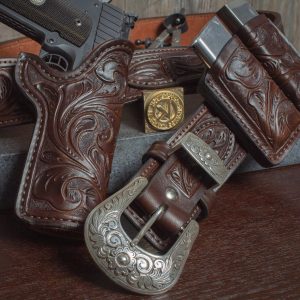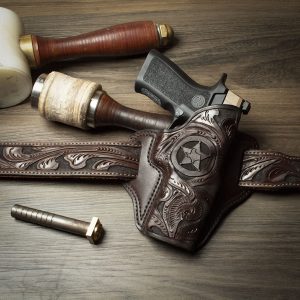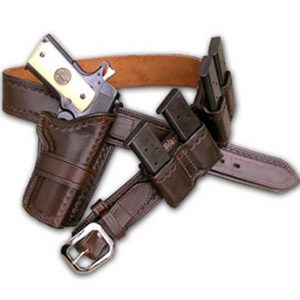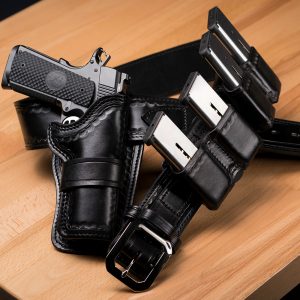Why Seasoned Officers Still Choose Leather: Real Talk on Duty Gear That Works
After watching gear trends come and go over the years, one thing becomes clear: when your paycheck depends on getting home safe, you don’t mess around with unproven equipment. While the tactical world chases the latest polymer wonder, experienced officers know there’s something to be said for leather that’s been protecting cops since the days of quick-draw duels at high noon.
Officers who’ve carried both synthetic and leather holsters through everything from foot pursuits in August heat to sitting surveillance in February sleet understand the difference. Here’s what the field teaches about why leather still has a place on the modern duty belt.
The Reality of 12-Hour Shifts
Anyone who’s worked patrol knows the difference between gear that looks good in the store and gear that feels good at hour ten of your shift. Officers regularly deal with synthetic holsters that dig into their ribs, create pressure points, or worse—lock up when they need their firearm most.
Quality leather breaks in like a good pair of boots. It conforms to your body, your weapon, and your carry style. After the first month, a properly made leather holster becomes an extension of your gear rather than something you’re fighting against.
When Presentation Matters: Court and Administrative Duty
Here’s where leather really shines, and where our specialized rigs make sense for specific law enforcement roles.
The Texas BBQ Rig
-
Texas BBQ Rig
$580.00 – $660.00Price range: $580.00 through $660.00 Select options This product has multiple variants. The options may be chosen on the product page
This isn’t your grandfather’s western rig—it’s a purpose-built system for officers who need to maintain a professional appearance while carrying openly. Detectives, court officers, and administrative personnel find these setups ideal when they need to be armed but can’t look like they just stepped off a SWAT truck.
The Texas BBQ Rig works particularly well for:
Court security officers who need visible deterrence without tactical intimidation
Administrative roles where you’re armed but dealing with the public regularly
Formal functions where officers need to be armed while maintaining their most professional appearance—ceremonies, official events, or high-profile assignments where looking sharp matters as much as being prepared
Wild Bunch Rig
-
Wild Bunch Rig – Model WBR
$580.00 – $850.00Price range: $580.00 through $850.00 Select options This product has multiple variants. The options may be chosen on the product page
For officers working specialized assignments where period-appropriate gear makes sense—think courthouse security in historic buildings or community policing roles where approachability matters—the Wild Bunch Rig provides authentic styling without sacrificing practical use.
Both rigs offer something synthetic can’t: they look intentional rather than tactical, professional rather than aggressive. Sometimes that distinction matters more than you’d think.
What Actually Matters in a Duty Holster
Retention That Works Under Stress
Officers who’ve been through hands-on encounters understand this: the best retention system is one that works instinctively when your fine motor skills have gone to hell. Quality leather molds to your specific weapon over time, creating natural retention that doesn’t require you to remember which button to push or which lever to flip.
Weather Performance
Contrary to what the synthetic crowd claims, properly treated leather handles weather better than most alternatives. Officers have carried leather holsters through everything from Gulf Coast humidity to Rocky Mountain snow. The key is buying from someone who knows how to finish leather properly—hand-burnished edges with protective coating aren’t just for looks.
Durability That Matters
Veteran officers know the value of gear that lasts. Quality leather holsters develop character over time—they darken where your hand naturally falls, shape to your specific carry style. You can’t get that kind of personalization from injection-molded plastic.
The Kirkpatrick Difference: Built by People Who Actually Shoot
What sets us apart isn’t just our seven decades in business—it’s that our people actually use this stuff. We compete in shooting sports and carry the pistols we’re training and competing with in our daily lives. When someone who’s been through a few hundred draws under timer pressure designs your holster, it shows in the details.
Our hand-molding process uses dummy firearms to get the fit right, but more importantly, we understand how a holster needs to perform when you’re not thinking about it. The draw stroke has to be consistent whether you’re fresh out of the academy or twenty years into your career.
Real-World Considerations
Break-in Period
New leather holsters need time to settle in. Plan on 2-3 weeks of regular wear before the holster really starts working with you instead of against you. Don’t judge a leather holster on day one—judge it on day thirty.
Maintenance Reality
Leather requires some attention, but less than you’d think. Annual conditioning, occasional cleaning, proper storage. If you can maintain your duty weapon, you can maintain a leather holster.
Cost vs. Value
Yes, quality leather costs more upfront. But when you factor in replacement costs over a career, leather often comes out ahead. Officers regularly go through three or four synthetic holsters in the time they’d use one leather rig.
Department Considerations
Professional Appearance
Some departments are moving back toward traditional leather for uniformed patrol because it projects authority without looking militaristic. There’s something about leather that says “police officer” rather than “tactical operator.”
Standardization Benefits
When everyone’s carrying the same style holster, training becomes more consistent. Officers can help each other with gear issues, and supervisors know what to expect from their people’s equipment.
Special Applications
Court officers: Leather provides a refined, professional appearance with secure carry. Community policing: Less intimidating than tactical gear while maintaining functionality. Administrative roles: Comfortable for extended desk work while remaining duty-ready.
The Bottom Line
I’m not bashing tactical gear—modern synthetic materials have their place, especially in specialized units where weight and environmental extremes matter more than comfort and longevity. But for the majority of law enforcement work—patrol, investigations, court security, administrative duties—quality leather still makes sense.
The officers who’ve stuck with leather aren’t doing it out of nostalgia. They’re doing it because after years of carrying a gun professionally, they’ve learned what actually works day in and day out. They’ve learned that the newest isn’t always the best, and that sometimes the old ways persist because they work.
When you’re looking at holsters, don’t just think about the first week you’ll wear it. Think about year five, year ten. Think about comfort during long shifts, durability through daily use, and performance when it actually matters. That’s where quality leather earns its keep.
If you’re considering leather for duty use, start with a conversation about your specific needs. We understand law enforcement applications because we live in that world. We know the difference between a holster that just looks good in photos and one that works when you need it to.
The choice isn’t really between old and new—it’s between gear that works with you and gear that works against you.
Contact Kirkpatrick Leather Company at 956-723-6893 or email support@kirkpatrickleather.com. Law enforcement discounts available (thank you for all that you do!)




